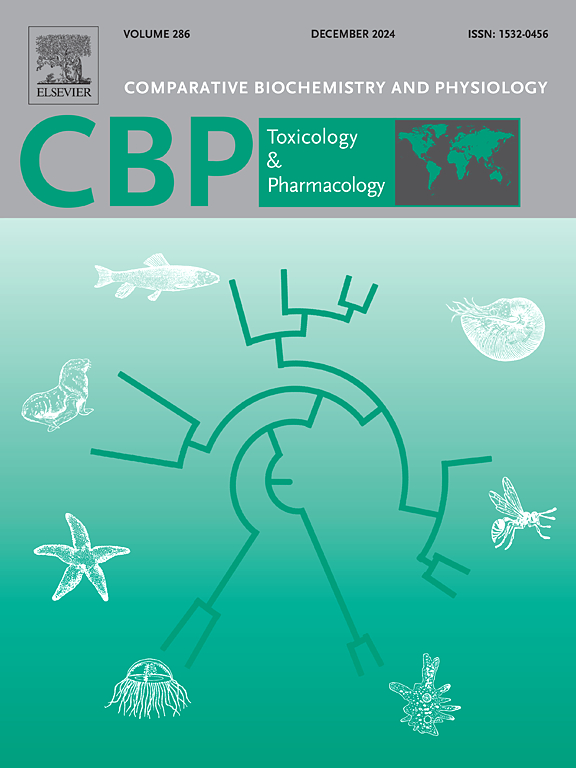Risk assessment of developmental and neurotoxicity by the flavoring agent perillaldehyde: NAC (N-acetylcysteine) mitigation of oxidative stress-mediated inhibition of the Nrf2 pathway
IF 3.9
3区 环境科学与生态学
Q2 BIOCHEMISTRY & MOLECULAR BIOLOGY
Comparative Biochemistry and Physiology C-toxicology & Pharmacology
Pub Date : 2024-11-15
DOI:10.1016/j.cbpc.2024.110071
引用次数: 0
Abstract
Perillaldehyde (PAE), a prevalent flavoring agent, has raised safety concerns due to conflicting evidence regarding its toxicity. This study provides a comprehensive assessment of the developmental and neurotoxic effects of PAE in zebrafish, elucidating the underlying mechanisms of its toxicity. Results showed that PAE affected the viability and hatching rate of zebrafish at 96 h postfertilization with the 50 % lethal concentration (LC50) of 7.975 mg/L. Furthermore, exposed to a non-lethal concentration of 4 mg/L PAE induced a spectrum of morphological abnormalities, such as pericardial edema, delayed yolk sac absorption, reduced body length, and microphthalmia. Behavioral observations revealed that PAE reduced motor ability, and was accompanied by an increase in spontaneous turning angle and angular velocity. Using the TG(elav13:EGFP) transgenic model, we observed the number of newborn neurons was reduced, indicating that PAE induced obvious neurotoxic effects. Additionally, this concentration facilitated the accumulation of reactive oxygen species (ROS) and malondialdehyde (MDA), concomitantly decreasing the activity of antioxidant enzymes. QRT-PCR analysis revealed that PAE down-regulated Nestin and Neurogenin1 gene expression, up-regulated Glipr1a and Nox1 gene expression, and inhibited the Nrf2/HO-1 pathway. Notably, co-administration of N-acetylcysteine (NAC), an inhibitor of oxidative stress, mitigated oxidative stress levels and partially ameliorated the neurotoxicity. These findings suggest that oxidative stress is the primary mediator of PAE-induced neurotoxicity. This study provides crucial insights for the safe application of PAE.
香料过甲醛对发育和神经系统毒性的风险评估:NAC(N-乙酰半胱氨酸)减轻氧化应激介导的 Nrf2 通路抑制作用。
紫苏醛(PAE)是一种常见的调味剂,由于有关其毒性的证据相互矛盾,因此引起了人们对其安全性的关注。本研究全面评估了 PAE 对斑马鱼的发育和神经毒性影响,阐明了其毒性的潜在机制。结果表明,PAE 会影响受精后 96 小时斑马鱼的存活率和孵化率,50%致死浓度(LC50)为 7.975 mg/L。此外,接触非致死浓度为 4 毫克/升的 PAE 会诱发一系列形态异常,如心包水肿、卵黄囊吸收延迟、体长缩短和小眼症。行为观察显示,PAE降低了运动能力,并伴随着自发转角和角速度的增加。利用TG(elav13:EGFP)转基因模型,我们观察到新生神经元数量减少,表明PAE诱导了明显的神经毒性效应。此外,该浓度还促进了活性氧(ROS)和丙二醛(MDA)的积累,同时降低了抗氧化酶的活性。QRT-PCR 分析显示,PAE 下调了 Nestin 和 Neurogenin1 基因的表达,上调了 Glipr1a 和 Nox1 基因的表达,并抑制了 Nrf2/HO-1 通路。值得注意的是,同时服用氧化应激抑制剂 N-乙酰半胱氨酸(NAC)可减轻氧化应激水平并部分改善神经毒性。这些发现表明,氧化应激是 PAE 诱导神经毒性的主要介质。这项研究为 PAE 的安全应用提供了重要启示。
本文章由计算机程序翻译,如有差异,请以英文原文为准。
求助全文
约1分钟内获得全文
求助全文
来源期刊
CiteScore
7.50
自引率
5.10%
发文量
206
审稿时长
30 days
期刊介绍:
Part C: Toxicology and Pharmacology. This journal is concerned with chemical and drug action at different levels of organization, biotransformation of xenobiotics, mechanisms of toxicity, including reactive oxygen species and carcinogenesis, endocrine disruptors, natural products chemistry, and signal transduction with a molecular approach to these fields.

 求助内容:
求助内容: 应助结果提醒方式:
应助结果提醒方式:


